+ Open data
Open data
- Basic information
Basic information
| Entry | Database: PDB / ID: 1p9r | ||||||
|---|---|---|---|---|---|---|---|
| Title | Crystal Structure of Vibrio cholerae putative NTPase EpsE | ||||||
 Components Components | General secretion pathway protein E | ||||||
 Keywords Keywords |  PROTEIN TRANSPORT / PROTEIN TRANSPORT /  Bacterial Type II secretion system cytoplasmic protein - GSPE / putative ATPase/ ATP binding protein / Metalloprotein (Metal-Cys4 site) Bacterial Type II secretion system cytoplasmic protein - GSPE / putative ATPase/ ATP binding protein / Metalloprotein (Metal-Cys4 site) | ||||||
| Function / homology |  Function and homology information Function and homology informationprotein-exporting ATPase activity /  protein-secreting ATPase / protein-secreting ATPase /  protein secretion by the type II secretion system / protein secretion by the type II secretion system /  type II protein secretion system complex / type II protein secretion system complex /  ATP hydrolysis activity / ATP hydrolysis activity /  ATP binding / ATP binding /  metal ion binding / metal ion binding /  plasma membrane plasma membraneSimilarity search - Function | ||||||
| Biological species |   Vibrio cholerae (bacteria) Vibrio cholerae (bacteria) | ||||||
| Method |  X-RAY DIFFRACTION / X-RAY DIFFRACTION /  SYNCHROTRON / SYNCHROTRON /  SAD / Resolution: 2.5 Å SAD / Resolution: 2.5 Å | ||||||
 Authors Authors | Robien, M.A. / Krumm, B.E. / Sandkvist, M. / Hol, W.G.J. | ||||||
 Citation Citation |  Journal: J.Mol.Biol. / Year: 2003 Journal: J.Mol.Biol. / Year: 2003Title: Crystal structure of the extracellular protein secretion NTPase EpsE of Vibrio cholerae Authors: Robien, M.A. / Krumm, B.E. / Sandkvist, M. / Hol, W.G.J. | ||||||
| History |
|
- Structure visualization
Structure visualization
| Structure viewer | Molecule:  Molmil Molmil Jmol/JSmol Jmol/JSmol |
|---|
- Downloads & links
Downloads & links
- Download
Download
| PDBx/mmCIF format |  1p9r.cif.gz 1p9r.cif.gz | 86.2 KB | Display |  PDBx/mmCIF format PDBx/mmCIF format |
|---|---|---|---|---|
| PDB format |  pdb1p9r.ent.gz pdb1p9r.ent.gz | 69 KB | Display |  PDB format PDB format |
| PDBx/mmJSON format |  1p9r.json.gz 1p9r.json.gz | Tree view |  PDBx/mmJSON format PDBx/mmJSON format | |
| Others |  Other downloads Other downloads |
-Validation report
| Arichive directory |  https://data.pdbj.org/pub/pdb/validation_reports/p9/1p9r https://data.pdbj.org/pub/pdb/validation_reports/p9/1p9r ftp://data.pdbj.org/pub/pdb/validation_reports/p9/1p9r ftp://data.pdbj.org/pub/pdb/validation_reports/p9/1p9r | HTTPS FTP |
|---|
-Related structure data
- Links
Links
- Assembly
Assembly
| Deposited unit | 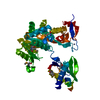
| ||||||||
|---|---|---|---|---|---|---|---|---|---|
| 1 |
| ||||||||
| Unit cell |
|
- Components
Components
| #1: Protein | Mass: 47118.906 Da / Num. of mol.: 1 / Fragment: N-terminal truncation of residues 1-90 Source method: isolated from a genetically manipulated source Source: (gene. exp.)   Vibrio cholerae (bacteria) / Gene: EPSE OR VC2732 / Plasmid: pQE70 / Production host: Vibrio cholerae (bacteria) / Gene: EPSE OR VC2732 / Plasmid: pQE70 / Production host:   Escherichia coli (E. coli) / Strain (production host): M15 / References: UniProt: P37093 Escherichia coli (E. coli) / Strain (production host): M15 / References: UniProt: P37093 |
|---|---|
| #2: Chemical | ChemComp-ZN / |
| #3: Chemical | ChemComp-CL /  Chloride Chloride |
| #4: Water | ChemComp-HOH /  Water Water |
-Experimental details
-Experiment
| Experiment | Method:  X-RAY DIFFRACTION / Number of used crystals: 1 X-RAY DIFFRACTION / Number of used crystals: 1 |
|---|
- Sample preparation
Sample preparation
| Crystal | Density Matthews: 2.73 Å3/Da / Density % sol: 54.99 % | ||||||||||||||||||||||||||||||||||||||||||||||||||||||||||||||||||||||
|---|---|---|---|---|---|---|---|---|---|---|---|---|---|---|---|---|---|---|---|---|---|---|---|---|---|---|---|---|---|---|---|---|---|---|---|---|---|---|---|---|---|---|---|---|---|---|---|---|---|---|---|---|---|---|---|---|---|---|---|---|---|---|---|---|---|---|---|---|---|---|---|
Crystal grow | Temperature: 293 K / Method: vapor diffusion, sitting drop / pH: 7.2 Details: PEG 200,3-morpholinopropanesulfonate, ammonium acetate, AMP-PNP, pH 7.2, VAPOR DIFFUSION, SITTING DROP, temperature 293.0K | ||||||||||||||||||||||||||||||||||||||||||||||||||||||||||||||||||||||
| Crystal grow | *PLUS pH: 6.3 / Method: vapor diffusion, sitting drop | ||||||||||||||||||||||||||||||||||||||||||||||||||||||||||||||||||||||
| Components of the solutions | *PLUS
|
-Data collection
| Diffraction | Mean temperature: 100 K |
|---|---|
| Diffraction source | Source:  SYNCHROTRON / Site: SYNCHROTRON / Site:  ALS ALS  / Beamline: 8.2.1 / Wavelength: 0.9748 Å / Beamline: 8.2.1 / Wavelength: 0.9748 Å |
| Detector | Type: ADSC QUANTUM 210 / Detector: CCD / Date: Aug 27, 2002 / Details: KOHZU: Double crystal: Si(111) |
| Radiation | Monochromator: Si(111) / Protocol: SINGLE WAVELENGTH / Monochromatic (M) / Laue (L): M / Scattering type: x-ray |
| Radiation wavelength | Wavelength : 0.9748 Å / Relative weight: 1 : 0.9748 Å / Relative weight: 1 |
| Reflection | Resolution: 2.5→60 Å / Num. obs: 18982 / % possible obs: 100 % / Observed criterion σ(F): 0 / Observed criterion σ(I): 0 / Redundancy: 12.7 % / Biso Wilson estimate: 48.8 Å2 / Rsym value: 0.102 / Net I/σ(I): 18.6 |
| Reflection shell | Resolution: 2.5→2.54 Å / Redundancy: 13.2 % / Mean I/σ(I) obs: 4.3 / Num. unique all: 930 / Rsym value: 0.653 / % possible all: 100 |
| Reflection | *PLUS Highest resolution: 2.5 Å / Redundancy: 12.71 % / Num. measured all: 241296 / Rmerge(I) obs: 0.102 |
| Reflection shell | *PLUS % possible obs: 65.3 % |
- Processing
Processing
| Software |
| ||||||||||||||||||||||||||||||||||||||||||||||||||||||||||||||||||||||
|---|---|---|---|---|---|---|---|---|---|---|---|---|---|---|---|---|---|---|---|---|---|---|---|---|---|---|---|---|---|---|---|---|---|---|---|---|---|---|---|---|---|---|---|---|---|---|---|---|---|---|---|---|---|---|---|---|---|---|---|---|---|---|---|---|---|---|---|---|---|---|---|
| Refinement | Method to determine structure : :  SAD SADStarting model: NONE Resolution: 2.5→50 Å / Cor.coef. Fo:Fc: 0.92 / Cor.coef. Fo:Fc free: 0.89 / SU B: 5.11 / SU ML: 0.123 / Isotropic thermal model: ISOTROPIC / Cross valid method: THROUGHOUT / σ(F): 0 / σ(I): 0 / ESU R: 0.571 / ESU R Free: 0.318 / Stereochemistry target values: MAXIMUM LIKELIHOOD
| ||||||||||||||||||||||||||||||||||||||||||||||||||||||||||||||||||||||
| Solvent computation | Ion probe radii: 0.8 Å / Shrinkage radii: 0.8 Å / VDW probe radii: 1.4 Å / Solvent model: BABINET MODEL WITH MASK | ||||||||||||||||||||||||||||||||||||||||||||||||||||||||||||||||||||||
| Displacement parameters | Biso mean: 39.879 Å2
| ||||||||||||||||||||||||||||||||||||||||||||||||||||||||||||||||||||||
| Refinement step | Cycle: LAST / Resolution: 2.5→50 Å
| ||||||||||||||||||||||||||||||||||||||||||||||||||||||||||||||||||||||
| Refine LS restraints |
| ||||||||||||||||||||||||||||||||||||||||||||||||||||||||||||||||||||||
| LS refinement shell | Resolution: 2.5→2.565 Å / Total num. of bins used: 20 /
| ||||||||||||||||||||||||||||||||||||||||||||||||||||||||||||||||||||||
| Refinement | *PLUS Highest resolution: 2.5 Å / Lowest resolution: 50 Å / Rfactor Rfree : 0.265 / Rfactor Rwork : 0.265 / Rfactor Rwork : 0.214 : 0.214 | ||||||||||||||||||||||||||||||||||||||||||||||||||||||||||||||||||||||
| Solvent computation | *PLUS | ||||||||||||||||||||||||||||||||||||||||||||||||||||||||||||||||||||||
| Displacement parameters | *PLUS | ||||||||||||||||||||||||||||||||||||||||||||||||||||||||||||||||||||||
| Refine LS restraints | *PLUS
|
 Movie
Movie Controller
Controller



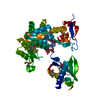


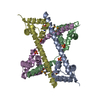


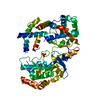
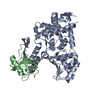
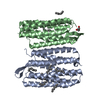
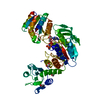
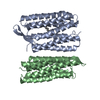
 PDBj
PDBj





